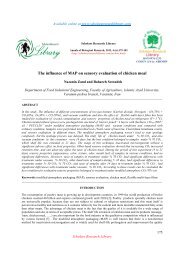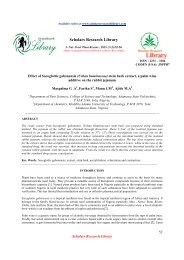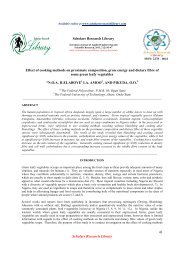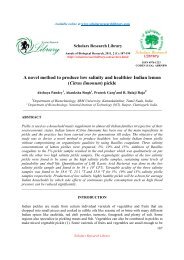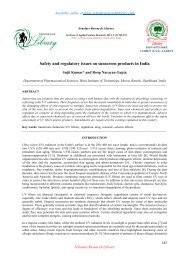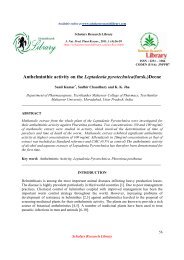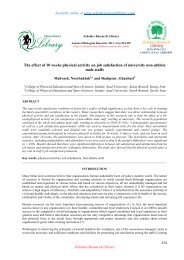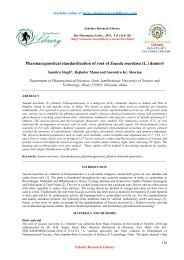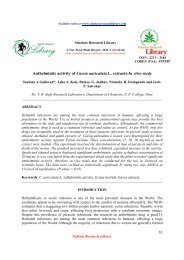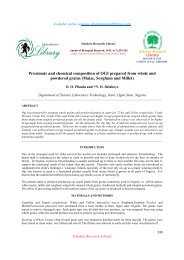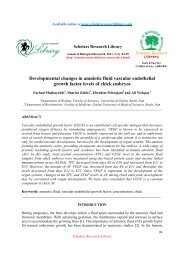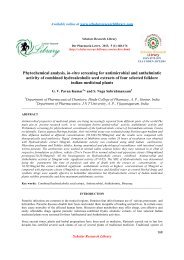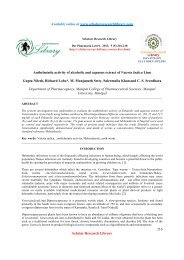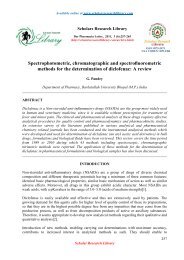Regulation for safety and quality of cosmetics vis - Scholars ...
Regulation for safety and quality of cosmetics vis - Scholars ...
Regulation for safety and quality of cosmetics vis - Scholars ...
You also want an ePaper? Increase the reach of your titles
YUMPU automatically turns print PDFs into web optimized ePapers that Google loves.
Sujit Kumar et al Der Pharmacia Lettre, 2012, 4 (1):181-191<br />
_____________________________________________________________________________<br />
considered as different types <strong>of</strong> products. Member States adopt the Cosmetic Ingredient Listings<br />
<strong>of</strong> the EU Cosmetic Directive 76/768/EEC including the latest amendments [5].<br />
CANADA<br />
The basis <strong>for</strong> the regulatory authority <strong>for</strong> the Cosmetics Program comes from the Food <strong>and</strong><br />
Drugs Act <strong>and</strong> Cosmetic <strong>Regulation</strong>s [10]. Ingredient is defined as any substance that is one <strong>of</strong><br />
the components <strong>of</strong> a cosmetic <strong>and</strong> includes colouring agents, botanicals, fragrance <strong>and</strong> flavour,<br />
but does not include substances that are used in the preparation <strong>of</strong> the cosmetic but that are not<br />
present in the final product as a result <strong>of</strong> the chemical process [6].<br />
All colouring agents, regardless <strong>of</strong> their concentration, may be listed in r<strong>and</strong>om order after the<br />
ingredients that are present at a concentration <strong>of</strong> more than 1% (as described in section 21.4(2) <strong>of</strong><br />
the Cosmetic <strong>Regulation</strong>s). It is also acceptable to list colouring agents in descending order <strong>of</strong><br />
predominance.<br />
For make-up products (e.g. lipstick, blush, eye shadow), nail polish <strong>and</strong> nail enamel, which are<br />
sold in a range <strong>of</strong> colour shades, all colouring agents used in the range may be listed if they are<br />
preceded by the symbol "+/-" or "±" or the phrase "may contain/peut contenir" (as described in<br />
section 21.2(2) <strong>of</strong> the Cosmetic <strong>Regulation</strong>s). It is unacceptable to use this notation <strong>for</strong> other<br />
cosmetic products, such as hair dyes [7].<br />
INDIA<br />
Cosmetics products in India is regulated under the Drugs <strong>and</strong> <strong>cosmetics</strong> Act 1940 <strong>and</strong> Rules<br />
1945. BIS (Bureau <strong>of</strong> Indian st<strong>and</strong>ards) sets the st<strong>and</strong>ards <strong>for</strong> <strong>cosmetics</strong> <strong>for</strong> the products listed<br />
under Schedule ‘S’ <strong>of</strong> the Drugs <strong>and</strong> <strong>cosmetics</strong> Rules 1945.<br />
Rule 148(7) <strong>of</strong> the Drugs <strong>and</strong> <strong>cosmetics</strong> Rules 1945 makes pro<strong>vis</strong>ion <strong>for</strong> listing <strong>of</strong> ingredients<br />
present in concentration <strong>of</strong> more than 1% shall be listed in the descending order <strong>of</strong> weight or<br />
volume at the time they are added, followed by those in concentration <strong>of</strong> less than or equal to 1%<br />
in any order <strong>and</strong> preceded by word “ingredients”......provided that this statement need not appear<br />
<strong>for</strong> packs <strong>of</strong> less than 60ml <strong>of</strong> liquids <strong>and</strong> 30gm <strong>of</strong> solid <strong>and</strong> semisolid [8].<br />
NOMENCLATURE OF COLOURS<br />
Identification <strong>of</strong> the colour additives on cosmetic product labels has been a discussion item <strong>for</strong><br />
many years between different regulatory bodies <strong>and</strong> the industry. There should be a simpler <strong>and</strong><br />
uni<strong>for</strong>m system <strong>of</strong> identifying these colour additives, one that could be used world-wide so that<br />
all cosmetic products use the same terminology <strong>for</strong> the same basic ingredients.<br />
EU<br />
For colouring agents use <strong>of</strong> INCI names is recommended. EEC directive mentions that colouring<br />
agents may be listed in any order after the other ingredients using the Colour Index (CI) Number<br />
or denomination adopted in annex IV [3].<br />
US<br />
The <strong>of</strong>ficial names <strong>for</strong> colour additives in the USA are designated by FDA [9]. Colours subject to<br />
batch certification are designated as food, drugs <strong>and</strong> <strong>cosmetics</strong> (FD&C), drugs <strong>and</strong> <strong>cosmetics</strong><br />
(D&C) or external drugs <strong>and</strong> <strong>cosmetics</strong> (Ext. D&C). This is followed by a colour designation,<br />
such as blue or red, <strong>and</strong> by No. (<strong>for</strong> number), <strong>and</strong> by a numeral. An example <strong>of</strong> such a name is<br />
FD&C Red No. 40. Colours made by combining these "straight" colours with "substrates"<br />
Scholar Research Library<br />
183



